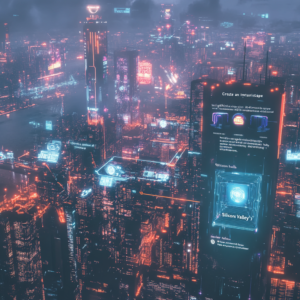Using perovskite to make LED pixels as small as a virus
Unlocking the Future: Perovskite LEDs Smaller Than a Virus
Currently, the most exciting frontier in display technology isn’t confined to your desktop monitors or flashy television screens. No, my dear reader, we are now talking about something straight out of a sci-fi novel—LED pixels so diminutive they boast a size comparable to that of a virus. Researchers from Zhejiang University and the University of Cambridge have taken a step into the unknown, pushing the limits of technology in a mind-boggling development using perovskite materials. Buckle in; we are diving into a world where pixels are not just smaller, but smarter.
Tiny Yet Mighty: The Perovskite Revolution
Before we plunge deeper, let’s address what this perovskite business is all about. Initially hailed for their potential in solar cells, perovskites have taken a delightful detour to the realm of display technology. Unlike conventional LEDs made from bulky III-V semiconductors—think gallium arsenide that are costly and lose efficiency when you try to slim them down—perovskites are the “cool kids” on the block. Their fantastic properties make them a compelling choice when you’re fishing for the next generation of electronic illumination[^1^][^3^].
At a jaw-dropping size of just 90 nanometers—yep, that’s the size of a virus!—this new breed of LED can achieve dazzling brightness without compromising efficiency. The magic lies in their localized contact fabrication, a fancy term that essentially means they dodge the pitfalls of light absorption that leave traditional pixels groping for breath in their quest for performance. With their 20% external quantum efficiency, these micro marvels outshine many of their predecessors, making you wonder why we didn’t leap on this sooner[^4^][^5^].
So, what does this pixel perfection translate into? Prepare to have your mind blown:
- Pixel Density: A mind-bending density of **127,000 Pixels Per Inch (PPI)**! For some context, current smartphones don’t even come close to this dizzying figure (hovering somewhere around **500 PPI**).
- Cost Efficiency: Instead of splurging on pricey crystal growth methods, perovskites yield a simpler manufacturing process utilizing lithography that is kinder on your wallet.
- Versatility: Currently, they shine in green and near-infrared wavelengths, but think of the berserk color palettes we could create when they branch out into full-color LED displays.[^1^][^3^][^5^]
Beyond the Ordinary: Game-Changing Applications Await
Picture this—ultra-slim augmented reality (AR) goggles that make current tech look like dinosaur bones. Wouldn’t that be something? While the applications are visionary, we haven’t quite crossed the finish line yet. The researchers have showcased their work through intriguing monochrome displays featuring charming tree imagery and globes, yet these could serve as mere teasers of what's to come[^3^][^4^]. Can you imagine an immersive AR experience made possible by these tiny wonders?
As stated by Prof. Baodan Zhao, “At extremely small sizes, perovskite LEDs still maintain reasonable efficiencies.” Now, how’s that for a bold declaration? It’s like putting a little Ferrari under the hood of your average sedans. Development of this pixel-frontier could shake up industries ranging from entertainment to healthcare, demanding high-fidelity visuals. But hold on—don’t round up your VR headsets just yet.
Braving the Challenges: The Dark Side of the Quest
With every rose comes its share of thorns, and there are bumps in the road ahead for these tiny tech titans. Here are the hurdles yet to be tackled:
-
Color Conundrums: Right now, these LEDs are monochromatic. Imagine that; they are like the grumpy gramps of the display world, limiting us to green and near-infrared. Getting a full color palette is essential, but the chemistry needs a bit more tinkering.[^1^][^5^]
-
Durability Doubts: How long can these micro marvels last? It’s an unanswered question for now, and an adventure into uncharted territory. Do they flutter like delicate butterflies, or stand the test of time? Only prolonged testing will unveil this mystery[4][^5^].
-
Manufacturing Maneuvering: While these LEDs might be cheaper in theory, full-scale consumer production is another monster entirely. Instead of just imagining the finished product, we need new tools and methods to maintain quality control[^2^][^5^].
A New Dawn in Display Technology: Embrace the Future
Why should you care about any of this? Well, stacking up these tiny punch-in-the-gut displays could democratize high-resolution screens, giving rise to ultra-sleek devices that redefine how we consume media. Picture this: ultra-slim VR goggles that let you do everything from doctor consultations to virtual gaming, all while holding resolutions that leap beyond current technology.
Perovskite LEDs possess the potential to disrupt long-held assumptions about screen tech. Remember Moore’s Law? What if the future’s trajectory diverges from traditional silicon paths and finds a new home in the realm of perovskite? As more talent pours into this burgeoning field, we could see astounding leaps that put “impossible” to shame, reaffirming that innovation often springs from the unlikeliest of sources.
As the research team succinctly emphasized: “This experiment demonstrates that at extremely small sizes, perovskite LEDs can still maintain reasonable efficiencies.” What more could we ask for? Conventional LEDs could be staring at their own obsolescence, paving the way for something fresher and more potent.
Want to stay up to date with the latest news on cutting-edge tech?
Subscribe to our Telegram channel: @channel_neirotoken
As we inch closer to an era where tech shrinks but brilliance expands, who knows what’s next? Perhaps breathable LED displays that light up without wires? Take your bets now, because the future is sporting some ultra-compact frights that are smaller than a virus!

